The South China Tiger Photographs
Why is the following story of interest? Because once again it shows the skepticism of Chinese netizens about official pronouncements. This case is about a peasant who took a photograph of a supposedly extinct wild South China tiger. This photographer has a vested interest in the case, because he has received monetary rewards; he is withholding the original film negatives because he thinks that he can get 500,000 yuan for the copyrights. The photograph was hyped by the Shaanxi Forestry Department, which has a vested interest in making a name at preserving rare (and assumed to be extintct) animal species. So why wouldn't the Chinese netizens be skeptical?
The Tiger
William Blake, 1757-1827TIGER, tiger, burning bright
In the forests of the night,
What immortal hand or eye
Could frame thy fearful symmetry?
(Xinhua via China Daily) Photo of 'extinct' tiger sparks controversy. October 18, 2007.
A newly-released photo, which Chinese forestry authorities say proves the continuing existence of wild South China tigers which have been thought to be extinct, has sparked heated controversy from Internet citizens, questioning its authenticity. The digital picture, purporting to be a wild South China tiger crouching in the midst of green bushes, was released by the Forestry Department of northwest China's Shaanxi Province at a news conference on October 12. Zhou Zhenglong, 52, a farmer and former hunter in Chengguan Township of Shaanxi's Zhenping County, photographed the tiger with a digital camera and on film on the afternoon of October 3, a department spokesman said. Experts had confirmed the 40 digital pictures and 31 film photographs are genuine, the spokesman told reporters.
But dozens of netizens expressed doubts about the authenticity of the digital picture -- the only one of the 71 taken to be released at the news conference -- after it had been posted on the Internet, especially in on-line forums discussing Photoshop (PS) technologies. Netizens suspected that the picture had been processed with PS technologies before release, citing the irregular effects of illumination and focus, and the unreal fur colour of the tiger. Some doubted whether the tiger is a wild one because its eyes look mild and dull, not frightening. While others said that the tiger's skin and hair seem too shiny, without three-dimensional effect, and speculated that the digital picture might be taken from another picture featuring a South China tiger, or even that a tiger picture was enlarged, made into cardboard cut-out and placed in bushes before being photographed.
The owner of the disputed photo, Zhou, from Wencai Village in Chengguan Township, was angered by the suspicious remarks. "It's beyond doubt that I really took the photos of a South China tiger. If they (netizens) have doubts about the photo provided by the forestry department, they can go and ask the officials," he said. Zhou acknowledged that he only gave two digital pictures to the forestry department, and besides, the two photos were not "the clearest ones." Zhou has been given 20,000 yuan (US$2,666) as a reward for finding the tiger by the Shaanxi forestry authorities. But Zhou, who believes he will be further hugely rewarded by authorities because of the photos, refused to show his original photos to reporters or anyone else. "I must protect my intellectual property rights for which I have risked my life," he said.
(Qihoo) Cardboard South China tiger passes expert examination, but doubts raised by sharp-eyed netizens. By 'First Impression 1' at Tianya:
According to the <Joint News Broadcast> on CCTV on October 13: "Recently, the rare wild South China has been found in Shaanxi after going out of sight for more than twenty years. A peasant in Ankong town, Ping county took a clear photograph of a wild South China tiger near a cliff. Experts have determined the photograph to be authentic."
At first sight, this photograph could not be more fake. The lighting, the expressions, the color, the environment ... how can this pass through the examination by experts on the South China wild tiger as well as photography experts? Did they make the examination with eyes shut?
I used the PhotoShop software and placed two photographs of the so-called wild South China tiger one on top of the other and found that the photographs which were shot from different angles and distances had the identical facial features, outlines, stripes and height! I even made an animated GIF file and published it along with the detailed description of y steps. Anyone with some experience in PhotoShop can replicate the production process.
The four most common doubts are:
(1) Three photographs of the same tiger taken at different positions and times had the same stripes in the same places. This was obviously either a paper tiger or model tiger placed there. [Note: One and only one photograph had been displayed at the press conference. The photojournalists took photographs of that original photograph, and this explains why other photographs looked so similar.]
(2) There were no tiger feces or footprints. [Note: This does not mean that there were no tiger feces or footprints -- it is just that no such photographs have been published by the photographer.]
(3) The color of the tiger is not in harmony with the surroundings.
(4) The photographer could have taken a closer photograph of the tiger through the use of a long-range lens. But the photographer did not do so. Furthermore, the focus of the photographs was on the tree leaves, not the tiger itself. [Note: The peasant who took the photographs was not a professional photographer. Besides, what photographer would dare to adjust the focus and take aim 20 meters from a tiger?]
The reporter then collected ten wildly circulated photographs and gave them to a photography expert to stupdy. Several photographs are different versions of the same photograph, including the original one released by the Shaanxi Department of Forestry. Using professional software, the reporter saw the EXIF information of each photograph. Some of these photographs had been subject to simple manipulation, such as color tone and photograph size. "The original photograph had intact EXIF information and the parameters were the same as claimed. After magnifying the edges between the tiger and the environment, no fakery could be detected."
It was also discovered that several of the photographs were shots taken of the original photograph. "The tiger on the original photograph is definitely not inserted by PhotoShop. But the focus was off, and it was impossible to examine the details. Therefore, the possibility cannot be excluded that this is a fake tiger model."
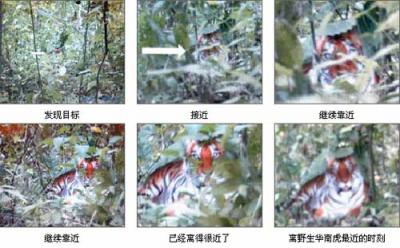
This is the series of photographs of the South China tiger from various distances and angles. Pro States in Flames pointed out that this wild South China tiger is very obedient because it maintains the same posture while keeping that highly controversial leaf right over its head all the time.
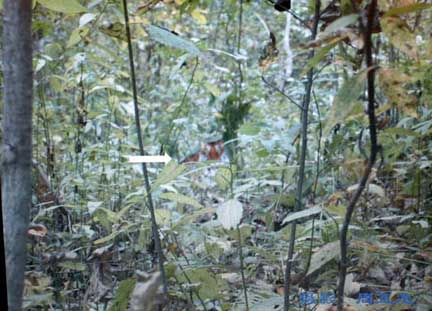
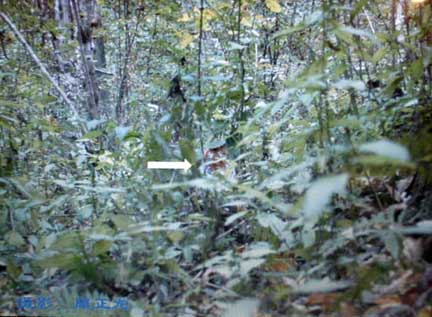
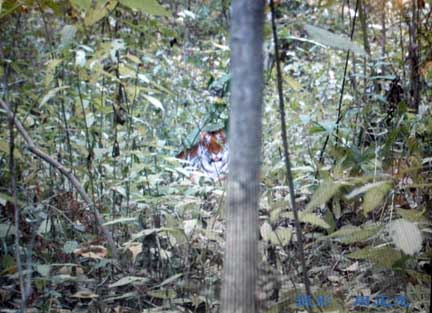

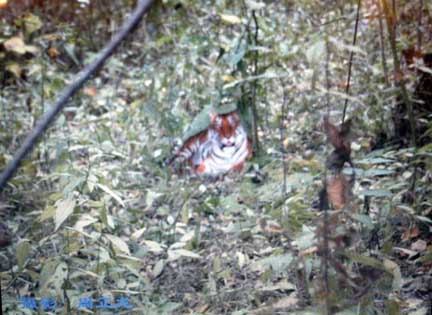
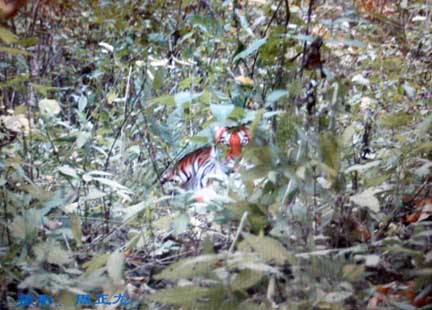
(Fu Jianfeng's blog) The Biggest Gamble in China: Three Heads Are On The Line! October 20, 2007.
[in translation]
Hey, brother, did you know that during the period of the seventeen party congress, some people are playing a game of life and death -- a third person has staked his life on it!
At this moment, the dying sun is bloody red ... but we still don't know whose heads will roll.
Let us talk about how the first head was put up.
About a week ago, the Shaanxi Forestry Department held a press conference to announce the discovery in the forests of Zhenping county of a wild South China Tiger previously thought to be extinct. This was a world-stunning news, because the "China tiger" is very rare.
Their evidence was based upon some photographs of a South China tiger taken by the local peasant Zhou Zhenglong.
But as soon as the photograph was released, doubts soared. From common netizens to animal experts, everybody was shouting that the tiger in the photograph was faked. Many people concluded that a paper tiger was placed in a forest and filmed.
This caused the Shaanxi Forestry Department to be very unhappy. The Animal Protection Bureau director Wang Wanyun gritted his teeth (I infer this because there was no photograph of this action) and told the media: "I am willing to guarantee the authenticity of this photograph with my head."
Actually, Wang Wanyun is being really cunning, because nobody is saying that the photograph is faked. People are saying that the tiger in the photograph is a fake paper tiger.
In any case, the first head has been placed on the gambling table.
When that happened, the situation quickly spun out of control. This was no longer a question of money; this was life and death.
And then the second head was placed among the stakes on the gambling table.
The second head came from the person who triggered all this -- the "hero who photographed the tiger," Zhou Zhenglong.
Previously, he was a famous hunter and impoverished villager. Then he became the guide to the South China tiger search team. The experts could not find a wild South China tiger no matter how they tried. So they tapped Zhou on the shoulder and said: "Old Zhou, if you can take a photograph of a South China tiger, the provincial government will award you with 1 million yuan!"
So Zhou Zhenglong became a "tiger fanatic." He dreamed about the tiger and the money day and night. He kept going up the mountain in the hope of getting a tiger photograph.
Many days later, he announced that he has the photographs.
But he was disappointed that the Shaanxi Forestry Department did not kept its promise. They were going to give him at most 20,000 yuan.
But he wanted one million yuan! So he refused to produce the photographs.
At a dinner, I heard a metro newspaper leader tell us about what Zhou Zhenglong did. Before the press conference, Zhou Zhenglong called this metro newspaper leader and asked: "I have photographs of the wild South China tiger. I am willing to sell them to you for 1 million yuan. Do you want them?" The leader thought that the telephone call came from a mental hospital.
But a couple days after the telephone call, the Shaanxi Forestry Department announced the news that "a wild South China tiger has been discovered."
Yet, the doubts soared and the Southern Metropolis Daily published the editorial titled <There is doubt about the South China tiger and further investigation is warranted> about this gamble with unique Chinese characteristics.
Southern Weekend also sent out reporters to record this gamble. Whereas Southern Weekend used to bide its time in reporting, it opted to use text, photographs and live digital video broadcasts at its new website http://www.infzm.com/ .
The principal character Zhou Zhenglong kept being asked by the reporters: Is your tiger real or fake?
Zhou Zhenglong roared with laughter and said, "If you want to look at one photograph, you pay me. If you want to look at two photographs, you pay me more."
Two newspaper reporters probed, "How about 50 yuan?" Zhou smirked and said: "How dare you offer that kind of price? I received 1,000 yuan when I appeared on the provincial television channel's program."
After the reporters paid a lot of money, Zhou took out the photographs and let them peek at them. But the reporters were still plagued with doubts and continued to question him.
So he made the bet: "I guarantee with my head that the photographs are authentic."
So two heads went on the gambling table because the situation was out of control. Meanwhile, the netizens had plenty of saliva to give, but who amongst them will gamble his head?
A hero finally emerged in the form of top Academy of Sciences researcher and plant expert Fu Dezhi.
At the Internet forum Yuanmu Shanchuan, he stated: "I am willing to guarantee with my head that the tiger in the photograph is fake."
His evidence has to do with the plants that appear around the photographs. From the photographs, the plants around the tiger were either oaks or hazelnuts. The leaves of these plants should be about 3 millimeters long. From the photographs, the leaf and the tigers were at the same distance away. In order to cover up the face of a real tiger, the leaves have to be as large as a wash basin. But here, a three-millimeter leaf was sufficient to cover up the head of the tiger. So the only possibility is that the tiger was take. The tiger should be a cropped photograph about 8 inch in size!
"If I identify these leaves incorrectly, then my two decades of plant research was wasted." This scientist told the Southern Weekend reporter.
He then acted as if out of kindheartedness and offered three options to the gambler Zhou Zhenglong.
Option 1, you faked a South China tiger and deceived the world. You should turn yourself in at the nearest public security bureau and confess that you did so to make a couple of yuan.
Option 2, you have the right to remain silent. Meanwhile, you to up the mountain quietly and hope that you can find a real South China tiger quickly. Or else, you ask God to come and help: Let there be light, and there was light; let there be a tiger, and there was a tiger.
Option 3, you try to get away with continuing your deception until the police car comes to your front door.
In gambling, there is a psychological battle as both sides yell and holler. The effect is stunning, but the consequences are serious.
Actually, during the period of the seventeenth party congress, there is no need to bet your heads; rather, you should say that you make this guarantee with your personal and party character.
Actually, people don't need their heads, they don't need to swear, they only need to know the truth ...
Flat Cat?A few weeks ago, tiger researchers celebrated the news that a South China tiger (Panthera tigris amoyensis) had been spotted--and photographed--in the wilds of Shaanxi Province. But netizens in China and elsewhere have declared it only a "paper tiger" after scrutinizing the two available images.
Although the species has been declared "functionally extinct," reports of tiger activity in the heavily forested Qinba Mountains prompted Shaanxi officials to offer a reward to anyone able to photograph one of the tigers.At a 12 October press conference in Xian, Zhou Zhenglong, a former hunter, told a rapt audience of his quest to photograph the beast, crawling to within 20 meters of one and snapping 71 images. When the camera's flash went off, the tiger roared and disappeared, he said.
Skeptics, citing factors such as the tiger's tame-looking expression and unreal coat color--as well as the fact that the two photos portray exactly the same tiger but differently positioned foliage-- think it's more likely that someone planted a cardboard tiger in the bushes. Fu Dezhi, a botanist at the Chinese Academy of Sciences, adds that the plants are not to scale in relation to the tiger. Zhou, who was paid 20,000 yuan ($2666) for the images, says, "I guarantee with my head that the photographs are authentic."
The Shaanxi Forestry Bureau is pushing ahead with plans for a thorough survey and a tiger reserve. "It's tremendously exciting news, if it can be substantiated," says tiger expert Gary Koehler of Washington state's Department of Fish and Wildlife (Science, 7 September, p. 1312). But first, "they need to look for hair snags or scat" for genetic verification.
The Science report is factually wrong in the second paragraph. There were two cameras, one using conventional film roll and the other is a Canon digital camera. The digital photographs contain EXIF information that includes the time as well as equipment. The flash was used earlier on in the sequence, not the last one.
(SCMP) Embarrassing tiger saga bites back at authorities Cynical observers unsatisfied by official response. By Shi Jiangtao. June 30, 2008.
Shaanxi authorities may want to put an end to the humiliating "paper tiger" saga and stop the embarrassment by pointing the finger at the man who faked the photos. But will the mainland public, who have waited nine months for an explanation, buy into the belated truth?
The answer, so far, appears negative. Many critics and netizens said they were not satisfied with the provincial authorities' announcement yesterday.
Zhou Zhenglong , 53, a hunter in mountainous Zhenping county who produced photos purporting to show a South China tiger alive in the wild and who repeatedly insisted they were genuine, has been arrested on fraud charges.
Seven officials were sacked, including Shaanxi forestry department's deputy director Zhu Julong - who pledged to resign should the photos prove to be fake - and six others were subject to disciplinary action.
Others dismissed from their posts include Sun Chengqian, another forestry department deputy, publicity chief Guan Ke and Wang Wanyun , in charge of wildlife preservation.
They were blamed for failing to expose Zhou's scam and being too hasty to announce the authenticity of the photos without seeking approval from the provincial government.
The announcement by the Shaanxi government said police seized a borrowed tiger poster as well as a wooden model of a tiger claw, which were allegedly used by Zhou to fabricate tiger photos and footprints.
Netizens and experts found that a South China tiger shown in a 2002 Lunar New Year poster looked identical to the one in Zhou's photos. But the official announcement yesterday did not explain why it took so long for authorities to admit Zhou's was merely a paper tiger.
Although the provincial government admitted its share of responsibility in the controversy and pledged to learn a lesson from it, officials did not offer an apology to the public - which had awaited an official verdict for months.
The provincial forestry authority was forced to apologise over its hasty release of the unverified photos in February amid intense pressure from the public and higher authorities. But it dodged the public demand for the results of the official investigation into the scandal ordered by the State Forestry Administration.
Critics complained about authorities' sluggish response to public inquiries and questioned the fairness of the government's handling of the scandal.
"A lot of important questions went unanswered in the government's handling of the Tigergate scandal," said Qiu Feng, a mainland commentator. "Why did government officials knowingly support the fabrication of tiger photos? What kind of political and legal responsibilities should the governments at all levels take?"
Hao Jingsong , a doctoral law student who has sued Zhou Zhenglong for fraud and called for investigations, said it was unfair and unconvincing to put most of the blame on Zhou. Many people believe the farmer couldn't have faked the photos himself, and that he wasn't responsible for the prolonged farce.
A big lie about the big cat that wasn't
October 3 Shaanxi hunter Zhou Zhenglong purportedly captures images of South China tiger in Zhenping
October 12 Shaanxi's forestry department announces tiger discovery
October 25 State Forestry Administration (SFA) sends experts to verify existence of tiger in Zhenping after netizens query photos
November 2 Chinese Academy of Sciences botanist says the photographs are fakes
November 15 Netizens say tiger image was cropped from a Lunar New Year poster
December 2 A panel of photography, zoology and botany experts dismisses the photos as fakes
December 19 SFA orders provincial forestry department to appoint government experts to authenticate photos
December 31 Shaanxi department admits release of authentication results delayed due to "immense public pressure"
February 3 Provincial government says forestry department breached procedures when it announced tiger discovery without seeking approval
February 4 Forestry department apologises to public for way it released photos; three officials suspended
March 4 Department admits no forensic agency was willing to authenticate the controversial photos
June 29 Provincial government admits photos were faked and announces that 13 local officials were sacked or punished, and that Zhou has been arrested
Related Links: